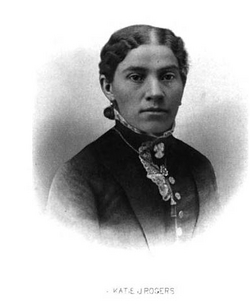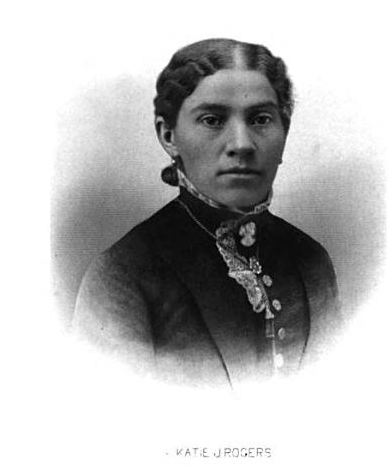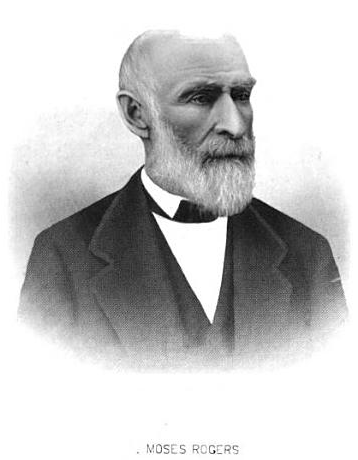Sister of Ellen A Rogers b Feb 12 1845, who died August 1862. They were the Rogers' only children.
-----
"Father Moses Rogers was also a self-made man. Rogers came from New York State at age twenty-one and first worked as a teamster, driving between Detroit and Ann Arbor. (This was in 1831; the railroad did not come to town until 1839.) He found employment in Chapin's farm implement store and in 1843 started his own implement store on Washington Street (where the Washington Street Station restaurant is now). He did so well that in 1860 he was able to move to much more spacious quarters on Catherine, to what was long known as the White Swan building and is now being remodeled as Market Place. The next year, he bought his family a home at 121 North Division, which is today part of the Division Street Historic District.
In 1866 Rogers sold his building and stock and soon joined in a partnership with John Treadwell and the two bought an old hotel, the Monitor, on the corner of Huron and Second Street and converted it into an implement store. According to an article in the March 8, 1867, Ann Arbor Argus, the plan was for Treadwell to be the proprietor and "avail himself of the aid and experience of Mr. Rogers." Rogers must have thought that after thirty-six years of hard work he could step down to an advisory position, but it was not to be. On April 15, 1870, a fire destroyed a group of neighboring downtown businesses. One casualty was the three-year-old implement business, which was uninsured.
Thus when Rogers bought Henning's building on Detroit Street in 1871, it was to start business anew at an age (sixty-one) when most people are thinking of retirement. Rogers had several advantages in this late-life endeavor, including a great knowledge of the implement business, a good reputation (Beakes's 1906 county history says, "He won an honorable name through the exercise of business principles that neither sought nor required disguise"), and a choice business location. Old Fourth Ward historian Susan Wineberg points out that Detroit Street would have been an excellent site for his business, located as it was on the main route between the railroad station and the downtown area, which in those days clustered around the County Courthouse at Huron and Main.
Moses Rogers lived seventeen years after founding his third business, and he managed to regain his former financial status. His obituary in 1883 described him as "one of the most prosperous merchants of the city."
After Rogers's death, his daughter, Katie, gave up her successful portrait painting career to take over the business, running it successfully for seven years. Katie Rogers had been a dutiful daughter all her life. Trained at the Chicago Academy of Design, where she graduated at the top of her class, she had returned home to set up a studio in her parents' home. She continued her art career, painting portraits of many local dignitaries, including her uncle, Randolph Rogers, a sculptor with an international reputation, and Judge James Kingsley. Her Kingsley portrait hung in the County Courthouse for many years.
Katie sold the implement business to Hurd-Holmes in 1895, enjoying what she could of retirement--by then she was an invalid--until her death in 1901. The business died before she did: the building is listed as vacant in the 1900 city directory."
Sister of Ellen A Rogers b Feb 12 1845, who died August 1862. They were the Rogers' only children.
-----
"Father Moses Rogers was also a self-made man. Rogers came from New York State at age twenty-one and first worked as a teamster, driving between Detroit and Ann Arbor. (This was in 1831; the railroad did not come to town until 1839.) He found employment in Chapin's farm implement store and in 1843 started his own implement store on Washington Street (where the Washington Street Station restaurant is now). He did so well that in 1860 he was able to move to much more spacious quarters on Catherine, to what was long known as the White Swan building and is now being remodeled as Market Place. The next year, he bought his family a home at 121 North Division, which is today part of the Division Street Historic District.
In 1866 Rogers sold his building and stock and soon joined in a partnership with John Treadwell and the two bought an old hotel, the Monitor, on the corner of Huron and Second Street and converted it into an implement store. According to an article in the March 8, 1867, Ann Arbor Argus, the plan was for Treadwell to be the proprietor and "avail himself of the aid and experience of Mr. Rogers." Rogers must have thought that after thirty-six years of hard work he could step down to an advisory position, but it was not to be. On April 15, 1870, a fire destroyed a group of neighboring downtown businesses. One casualty was the three-year-old implement business, which was uninsured.
Thus when Rogers bought Henning's building on Detroit Street in 1871, it was to start business anew at an age (sixty-one) when most people are thinking of retirement. Rogers had several advantages in this late-life endeavor, including a great knowledge of the implement business, a good reputation (Beakes's 1906 county history says, "He won an honorable name through the exercise of business principles that neither sought nor required disguise"), and a choice business location. Old Fourth Ward historian Susan Wineberg points out that Detroit Street would have been an excellent site for his business, located as it was on the main route between the railroad station and the downtown area, which in those days clustered around the County Courthouse at Huron and Main.
Moses Rogers lived seventeen years after founding his third business, and he managed to regain his former financial status. His obituary in 1883 described him as "one of the most prosperous merchants of the city."
After Rogers's death, his daughter, Katie, gave up her successful portrait painting career to take over the business, running it successfully for seven years. Katie Rogers had been a dutiful daughter all her life. Trained at the Chicago Academy of Design, where she graduated at the top of her class, she had returned home to set up a studio in her parents' home. She continued her art career, painting portraits of many local dignitaries, including her uncle, Randolph Rogers, a sculptor with an international reputation, and Judge James Kingsley. Her Kingsley portrait hung in the County Courthouse for many years.
Katie sold the implement business to Hurd-Holmes in 1895, enjoying what she could of retirement--by then she was an invalid--until her death in 1901. The business died before she did: the building is listed as vacant in the 1900 city directory."
Sponsored by Ancestry
Advertisement
Explore more
Sponsored by Ancestry
Advertisement



